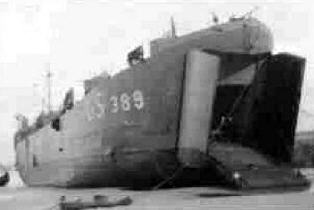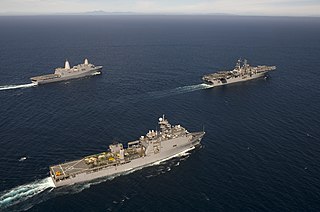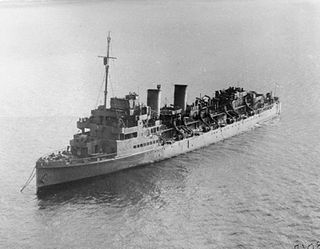
The Albion-class landing platform dock is a class of amphibious warfare ship in service with the Royal Navy. The class consists of two vessels, HMS Albion and HMS Bulwark, ordered in 1996 to replace the ageing Fearless class. Both ships were built by BAE Systems Marine at the former Vickers Shipbuilding and Engineering yard in Barrow-in-Furness. Albion was commissioned in 2003 and Bulwark in 2004. Each of the ships has a crew of 325 and can accommodate up to 405 troops. Thirty-one large trucks and thirty-six smaller vehicles and main battle tanks can be carried inside the vehicle deck. To disembark troops and vehicles, the vessels are equipped with eight landing craft. As of 2024, both vessels were in reserve.

RFA Mounts Bay is a Bay-class auxiliary landing ship dock of the Royal Fleet Auxiliary. She is named after Mount's Bay in Cornwall.

Landing craft are small and medium seagoing watercraft, such as boats and barges, used to convey a landing force from the sea to the shore during an amphibious assault. The term excludes landing ships, which are larger. Production of landing craft peaked during World War II, with a significant number of different designs produced in large quantities by the United Kingdom and United States.

The landing craft, tank (LCT) was an amphibious assault craft for landing tanks on beachheads. They were initially developed by the Royal Navy and later by the United States Navy during World War II in a series of versions. Initially known as the "tank landing craft" (TLC) by the British, they later adopted the U.S. nomenclature "landing craft, tank" (LCT). The United States continued to build LCTs post-war, and used them under different designations in the Korean and Vietnam Wars.

Landing Ship, Tank (LST), or tank landing ship, is the naval designation for ships first developed during World War II (1939–1945) to support amphibious operations by carrying tanks, vehicles, cargo, and landing troops directly onto a low slope beach with no docks or piers. The shallow draft and bow doors and ramps enabled amphibious assaults on almost any beach.

HMS Eagle was an early aircraft carrier of the Royal Navy. Ordered by Chile during the South American dreadnought race as the Almirante Latorre-class battleship Almirante Cochrane, she was laid down before World War I. In early 1918 she was purchased by Britain for conversion to an aircraft carrier; this work was finished in 1924. Her completion was delayed by labour troubles and the possibility that she might be repurchased by Chile for reconversion into a battleship, as well as the need for comparative trials to determine the optimum layout for aircraft carriers. The ship was initially assigned to the Mediterranean Fleet and then later to the China Station, spending very little time in home waters other than for periodic refits.

USS Samuel Chase (APA-26), launched as SS African Meteor, was an Arthur Middleton-class attack transport manned by the United States Coast Guard during World War II. She was named after Founding Father Samuel Chase, a signatory to the Declaration of Independence.

USS LST-519 was an LST-491-class tank landing ship built for the U.S. Navy in World War II. She was later renamed USS Calhoun County (LST-519) after counties in eleven states in the United States.

USS LST-209 was an LST-1-class tank landing ship built for the United States Navy during World War II. Like most of the ships of her class, she was not originally named, and known only by her designation. From June to August 1951 she served a stint as a part of the Military Sea Transportation Service (MSTS), manned by a civilian crew, and renamed USNS T-LST-209. She was recommissioned under her original name 24 August 1951, and renamed USS Bamberg County (LST-209) on 1 July 1955. She was named for Bamberg County, South Carolina, the only U.S. Naval vessel to bear the name.

USS Berkeley County (LST-279) was an LST-1-class tank landing ship built for the United States Navy during World War II. Named for counties in South Carolina and West Virginia, she was the only U.S. Naval vessel to bear the name.

USS Bernalillo County (LST-306) was an LST-1-class tank landing ship built for the United States Navy during World War II. Named for Bernalillo County, New Mexico, she was the only U.S. Naval vessel to bear the name.

USS Boone County (LST-389) was an LST-1-class tank landing ship built for the United States Navy during World War II. Named for counties in Arkansas, Illinois, Indiana, Iowa, Kentucky, Missouri, Nebraska, and West Virginia, she was the only U.S. Naval vessel to bear the name.

USS Middlesex County (LST-983) was an LST-542-class tank landing ship built for the United States Navy during World War II. Named after counties in Connecticut, Massachusetts, New Jersey, and Virginia, she was the only United States Navy vessel to bear the name.
USS Thurston (AP-77) was a troop transport that served with the United States Navy during World War II. She was named after counties in Nebraska and Washington.

An amphibious warfare ship is an amphibious vehicle warship employed to land and support ground forces, such as marines, on enemy territory during an amphibious assault.
HMS Misoa was a Maracaibo-class LST Mk.I tank landing ship of the British Royal Navy during World War II. A converted Lake Maracaibo oil tanker, she took part in the invasions of North Africa, Sicily, and Normandy.

SS Prinses Astrid was a Belgian cross-Channel ferry struck a naval mine 3 nautical miles (5.6 km) off the coast of Dunkirk, France and sank with the loss of five of her 65 crew. All 60 survivors and 218 passengers on board were rescued by SS Cap Hatid (France) and various tugs from Dunkirk.

The Type B ship is a United States Maritime Administration (MARAD) designation for World War II barges. Barges are very low cost to build, operate and move. Barges were needed to move large bulky cargo. A tug boat, some classed as Type V ships, could move a barge, then depart and move on to the next task. That meant the barge did not have to be rushed to be unloaded or loaded. Toward the end of World War 2, some ships that had not been completed in time for the war were converted to barges. US Navy barges are given the prefix: YWN or YW. Due to shortage of steel during World War II, concrete ship constructors were given contracts to build concrete barges, with ferrocement and given the prefix YO, YOG, YOGN. Built in 1944 and 1945, some were named after chemical elements.

USS LST-779 was a United States Navy LST-542-class tank landing ship used in the Asiatic-Pacific Theater during World War II.

HMS Bachaquero(F110) was a Maracaibo-class Mark I landing ship, tank of the Royal Navy during World War II. A converted Lake Maracaibo oil tanker.

















